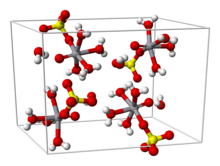
Back كبريتات الفاناديل Arabic وانادیل سولفات AZB Sulfat de vanadil Catalan Vanadylsulfat German وانادیل سولفات Persian Vanadyylisulfaatti Finnish वनडाइल सल्फेट Hindi Сульфат ванадила Russian Vanadil sülfat Turkish 硫酸氧钒 WUU

| |

| |
| Names | |
|---|---|
| IUPAC name
Oxovanadium(2+) sulfate
| |
| Other names
Basic vanadium(IV) sulfate
Vanadium(IV) oxide sulfate Vanadium(IV) oxysulfate | |
| Identifiers | |
| |
| ECHA InfoCard | 100.044.214 |
PubChem CID
|
|
| RTECS number |
|
| UNII |
|
CompTox Dashboard (EPA)
|
|
| |
| Properties | |
| H10O10SV | |
| Molar mass | 253.07 g·mol−1 |
| Appearance | Blue solid |
| Melting point | 105 °C (221 °F; 378 K) decomposes |
| Soluble | |
| Hazards | |
| Occupational safety and health (OHS/OSH): | |
Main hazards
|
Irritant |
| Flash point | Non-flammble |
| Related compounds | |
Other anions
|
Vanadyl chloride Vanadyl nitrate |
Other cations
|
Vanadium(III) sulfate |
Related compounds
|
Vanadyl acetylacetonate |
Except where otherwise noted, data are given for materials in their standard state (at 25 °C [77 °F], 100 kPa).
| |

Vanadyl(IV) sulfate describes a collection of inorganic compounds of vanadium with the formula, VOSO4(H2O)x where 0 ≤ x ≤ 6. The pentahydrate is common. This hygroscopic blue solid is one of the most common sources of vanadium in the laboratory, reflecting its high stability. It features the vanadyl ion, VO2+, which has been called the "most stable diatomic ion".[1]
Vanadyl sulfate is an intermediate in the extraction of vanadium from petroleum residues, one commercial source of vanadium.[2]
- ^ Greenwood, Norman N.; Earnshaw, Alan (1984). Chemistry of the Elements. Oxford: Pergamon Press. p. 1157. ISBN 978-0-08-022057-4.
- ^ Günter Bauer; Volker Güther; Hans Hess; Andreas Otto; Oskar Roidl; Heinz Roller; Siegfried Sattelberger (2005). "Vanadium and Vanadium Compounds". Ullmann's Encyclopedia of Industrial Chemistry. Weinheim: Wiley-VCH. doi:10.1002/14356007.a27_367. ISBN 3-527-30673-0.
© MMXXIII Rich X Search. We shall prevail. All rights reserved. Rich X Search